View in other NatureServe Network Field Guides
NatureServe
Montana
Utah
Wyoming
Idaho
Wisconsin
British Columbia
South Carolina
Yukon
California
New York
Northern Rocky Mountains Refugium Caddisfly - Sericostriata surdickae
State Rank Reason (see State Rank above)
This Northern Rocky Mountains Refugium Caddisfly is currently ranked a "S3" Potential Species of Concern in MT and is potentially at risk because of limited and/or potentially declining population numbers, range and/or habitat, making it vulnerable. This species was ranked a species of concern in 2006, but additional occurrence records and range expansions has moved it to the Potential Species of Concern list.
- Details on Status Ranking and Review
Northern Rocky Mountains Refugium Caddisfly (Sericostriata surdickae) Conservation Status Review
Review Date = 09/18/2008
Population Size
ScoreU - Unknown
CommentUnknown.
Range Extent
ScoreE - 5,000-20,000 km squared (about 2,000-8,000 square miles)
Comment5000-20,000km (2,000-8,000square miles)
Area of Occupancy
Comment200-1000 km (125-620 miles) linear river
Length of Occupancy
ScoreLD - 200-1,000 km (about 125-620 miles)
Long-term Trend
ScoreD - Moderate Decline (decline of 25-50%)
CommentSiltation and stream temperature increases with loss of riparian shading and lower snowpack probably contributed to some decline
Short-term Trend
ScoreE - Stable. Population, range, area occupied, and/or number or condition of occurrences unchanged or remaining within ±10% fluctuation
Threats
ScoreG - Slightly threatened. Threats, while recognizable, are of low severity, or affecting only a small portion of the population or area.
CommentClimate Change, increasing stream temperatures and lower snowpack could seriously impact the habitat that this speces exists in
SeverityLow - Low but nontrivial reduction of species population or reversible degradation or reduction of habitat in area affected, with recovery expected in 10-50 years.
ScopeLow - 5-20% of total population or area affected
ImmediacyLow - Threat is likely to be operational within 5-20 years.
CommentThreat is not fully operational now, but some areas have been lost.
Intrinsic Vulnerability
ScoreC - Not Intrinsically Vulnerable. Species matures quickly, reproduces frequently, and/or has high fecundity such that populations recover quickly (< 5 years or 2 generations) from decreases in abundance; or species has high dispersal capability such that extirpated populations soon become reestablished through natural recolonization (unaided by humans).
Environmental Specificity
ScoreB - Narrow. Specialist. Specific habitat(s) or other abiotic and/or biotic factors (see above) are used or required by the Element, but these key requirements are common and within the generalized range of the species within the area of interest.
CommentCold water stenotherm, cannot survive increases in water temperatures or will have to migrart to cooler temps
General Description
The larvae of the caddisfly, S. surdickae occur on the upper surfaces of rockfaces and boulders in high gradient, perennially flowing, cold mountain streams of the Rocky Mountain Refugium Area (ID/MT boundary area). The transverse banding and longitudinal ridges of the larval case of Sericostriata makes it very distinctlive.
Diagnostic Characteristics
Adult morphology: Taxonomy of adults is covered in Wiggins et al.(1985). The adults are known as Little Western Dark Sedges.
Larval morphology: Body length: 8-10 mm. Larvae of Sericostriata surdickae could be confused with larvae of Farula and Neothremma, but are readily distinguished by the angulate anterolateral corners of the pronotum and mesonotum. The ventral apotome of the head of Sericostriata is longer and separates the gena more than in related genera. The transverse banding and longitudinal ridges of the larval case of Sericostriata is also considerably different from that of Farula and Neothremma.
Species Range
Montana Range
Range Descriptions
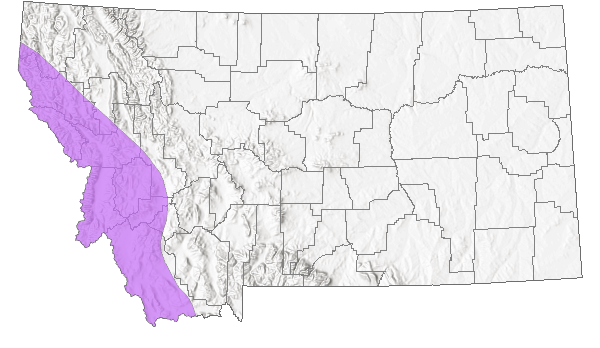
 Native
Native
Range Comments
Rangewide, Sericostriata surdickae is a regional endemic only known to occur in Idaho and Montana (Wiggins 1996, NatureServe 2006).
In Montana, Sericostriata surdickae has been reported from Missoula, Mineral, Granite, Powell and Sanders Counties.
In Idaho, Sericostriata surdickae has been reported from 4 counties including Idaho and Valley County in west-central Idaho; and Elmore and Lemhi counties.
Observations in Montana Natural Heritage Program Database
Number of Observations: 42
(Click on the following maps and charts to see full sized version)
Map Help and Descriptions
Relative Density
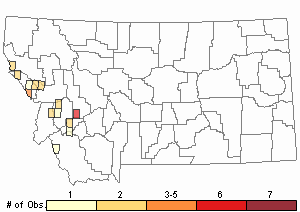
Recency
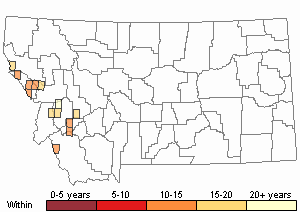

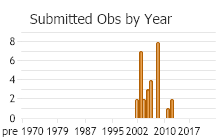
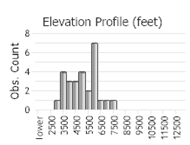 (Observations spanning multiple months or years are excluded from time charts)
(Observations spanning multiple months or years are excluded from time charts)
Habitat
The larvae of S. surdickae occur on the upper surfaces of rocks in high gradient, perennially flowing, cold mountain streams (Wiggins1996, see photo). The trophic relationship of Sericostriata larvae include scrapers and collectors-gatherers (detritus, diatoms) (Merritt and Cummins 1996).
Reproductive Characteristics
In Idaho, collections indicate that at least 2 years are required to complete the life cycle. Adults of this species emerge from mid-July to mid-August (Wiggins 1996).
Management
Sericostriata surdickae has been described as a rare species due to habitat specificity and is never abundant when collected (Wiggins 1996). It has no USFWS status at the present time, although it is currently a US Forest Service Species of Concern (SOC); ranked globally rare/uncommon (G1G2) by Natureserve (2006), but unranked (SNR) in Montana and a state rank has not been reported for Idaho.
Stewardship Responsibility
Threats or Limiting Factors
Specific threats to Montana & Idaho populations of S.surdickae would include mismanagement of forested riparian areas, including sediment and temperature increases associated with road building and timber harvests not following BMPs. In general, stenothermic (cold-loving) invertebrate populations are affected by changes to aquatic habitat, such as alteration of flow patterns, streambed substrate, thermal characteristics, and water quality. Alteration and degradation of riparian and aquatic habitat is the primary concern for Idaho and Montana populations.
References
- Web Search Engines for Articles on "Northern Rocky Mountains Refugium Caddisfly"
- Additional Sources of Information Related to "Insects"





